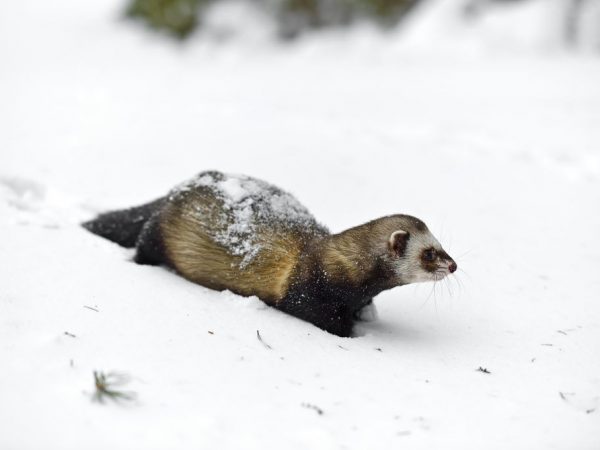Black forest ferret
An inhabitant of the Eurasian territory, the forest polecat, due to its dark color, is also known as black or dark. The common ferret naturally crosses freely, giving a varied color palette.

Forest ferret
general description
The wild ferret, which is widespread in the wild, has domesticated species:
- home type ferret, or furo, - a pet of black, brown, white or mixed colors,
- The albino ferret is an animal with pure white fur.
The wild black forest ferret is known as a furry animal with valuable fur, but its small numbers prohibit hunting for it. Inhabitants of rural areas do not like forest predators because of their hunting instincts, which often lead wild animals to poultry houses. However, small in size, it acts as a rodent exterminator, which brings irreplaceable benefits.
The black forest ferret is protected in many countries of the world and is listed in the Red Book.
The external description of the wild forest ferret practically does not differ from the description of most relatives from the order of martens, the traces of which are similar. As a rule, these are short-legged, squat animals with sharp and long claws. Their body is elongated in length by 0.36-0.48 m, ends with a long, up to 17 cm, tail. The weight of the average forest ferret ranges from 0.4 to 038 kg, while the weight of females is approximately 1.5 times less than that of males, their tail is also noticeably shorter: up to 15 cm in length.
The adult forest ferret in the photo can be recognized by its characteristic color: black abdomen, paws, thoracic region, neck and tail, without a sharp contrast, which distinguishes it from the steppe species. In some variations, there are red individuals or pure whites.
A distinctive external feature of not only forest, but also other troches is their facial mask: a specific contrasting ornament.
The ducts of the anal glands located under the tail produce a secret that has a pungent smell and serves as a way for the forest polecat to scare away ill-wishers.
Habitat
The range of the ferret covers the entire territory of the Eurasian continent. The common ferret can be found in all regions of Western Europe, regardless of the fact that the geographical area of its habitat is noticeably decreasing. A large population of forest ferrets is found in England and practically throughout the entire European area of Russia, with the exception of the Lower Volga and Caucasian regions, as well as bypassing North Karelia.
Over the past few decades, the ferret's range has moved towards the Finnish border. There are several representatives of black ferrets in the woodlands of the northwest African continent.
Some time ago, the forest ferret was transported to distribute it to New Zealand. The main purpose for growing these animals in a new habitat was the fight against rodents: mice and rats. However, the ferrets, easily adapting and taking root in the new conditions, began to pose a threat to the New Zealand indigenous fauna.
Habits
By their nature, forest ferrets are rather aggressive animals that can withstand large animals. The animal goes hunting at nightfall, while in the daytime it sleeps in shelters, from which it rarely comes out during daylight hours. He catches his prey right on the run or keeps watch near the minks.
Due to the desire to hunt on the forest edges, the forest ferret received the nickname of the forest predator.
The ferret is classified as a sedentary wild animal tied to a specific place of residence. As a habitat, the animal prefers small covering shelters in the form of dead woods, rotten stumps, and haystacks. In some cases, the forest ferret occupies other people's burrows - the former homes of badgers and foxes. In the conditions of the village and village, the animals settle down in sheds and cellars, sometimes they build themselves shelters under the bath roofs.
The ferret almost never pulls out its own minks.
For their place of residence, ferrets choose small forests and groves mixed with meadow glades. Ferrets avoid settling in the taiga. Weasels are often seen near rivers and nearby other bodies of water. This animal can swim, however, it does not differ in increased skills, in contrast to its related European minks.
Nutrition and reproduction
The ferret reaches sexual maturity at the age of 1 year. With the onset of spring, from April to May, the rut begins in the animal. In some cases, it drags on until the second half of June. The duration of pregnancy of a female ferret is 1.5 months. One litter gives birth to 4 to 6 cubs. A natural instinct makes troches to protect the offspring that has appeared in front of any danger.
Little hooryats begin to eat the main adult meat food at the end of the mother's lactation period. Many of them have a so-called juvenile mane on the nape: hairs that are elongated in comparison with the rest of the fur. New offspring live close to the mother until the fall season, in some cases even up to spring.
In nature, hybrids of a forest ferret with a mink, called honorics, often appear.
Black forest choris are mouse-eaters. The main part of their diet consists of small rodents such as voles. In the summer months, the animal can catch frogs and small-sized water rats, sometimes hunts for snakes and even small birds. Also, large insects like locusts are often used as food.
When living close to humans, the polecat often hunts poultry and rabbits.


